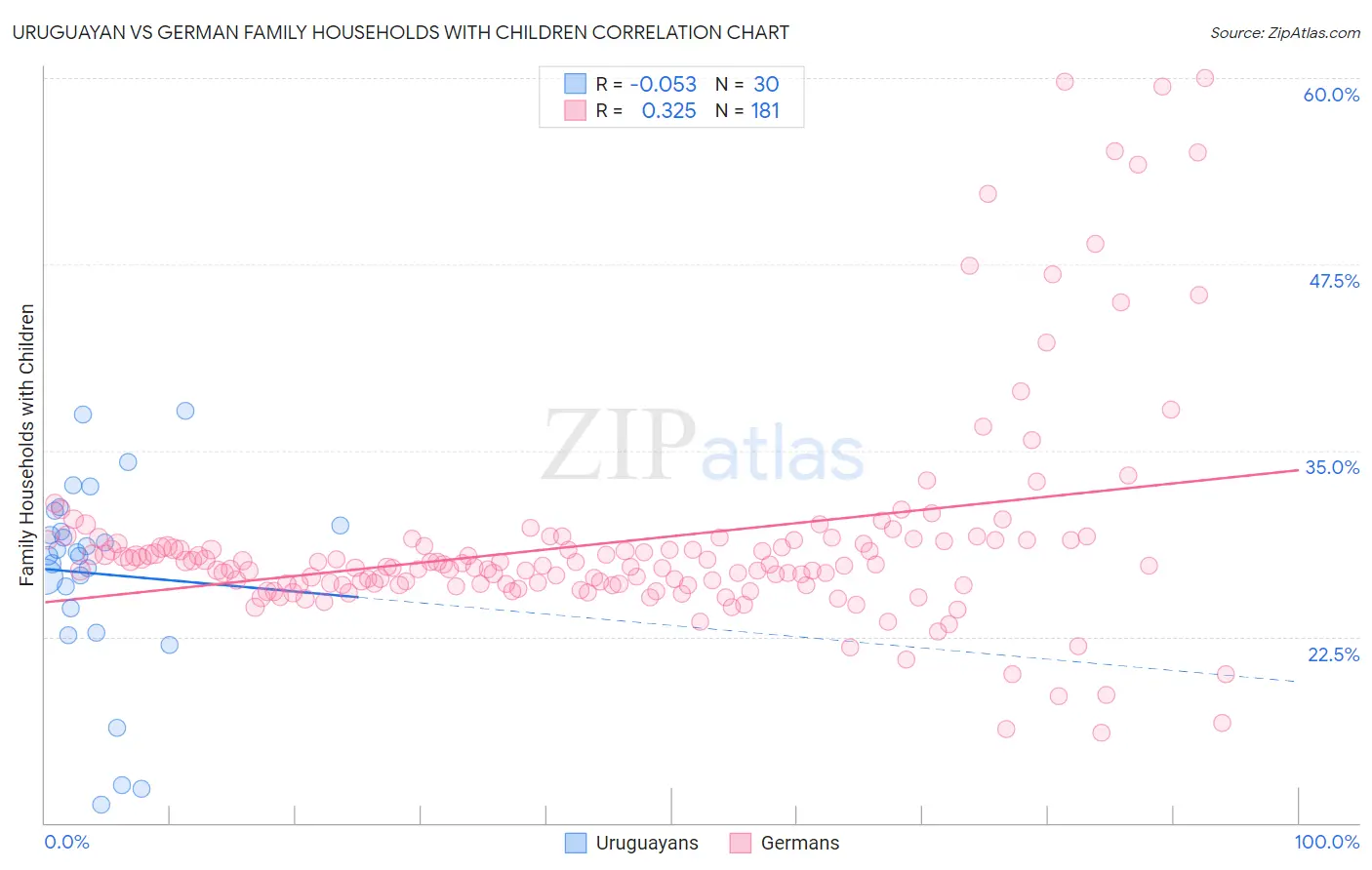Uruguayan vs German Family Households with Children
COMPARE
Uruguayan
German
Family Households with Children
Family Households with Children Comparison
Uruguayans
Germans
27.7%
FAMILY HOUSEHOLDS WITH CHILDREN
83.2/ 100
METRIC RATING
138th/ 347
METRIC RANK
27.1%
FAMILY HOUSEHOLDS WITH CHILDREN
8.7/ 100
METRIC RATING
224th/ 347
METRIC RANK
Uruguayan vs German Family Households with Children Correlation Chart
The statistical analysis conducted on geographies consisting of 144,747,065 people shows a slight negative correlation between the proportion of Uruguayans and percentage of family households with children in the United States with a correlation coefficient (R) of -0.053 and weighted average of 27.7%. Similarly, the statistical analysis conducted on geographies consisting of 579,972,630 people shows a mild positive correlation between the proportion of Germans and percentage of family households with children in the United States with a correlation coefficient (R) of 0.325 and weighted average of 27.1%, a difference of 2.2%.

Family Households with Children Correlation Summary
| Measurement | Uruguayan | German |
| Minimum | 11.3% | 16.1% |
| Maximum | 37.6% | 60.0% |
| Range | 26.4% | 43.9% |
| Mean | 26.7% | 28.8% |
| Median | 28.0% | 27.3% |
| Interquartile 25% (IQ1) | 24.4% | 26.0% |
| Interquartile 75% (IQ3) | 30.0% | 29.0% |
| Interquartile Range (IQR) | 5.6% | 3.0% |
| Standard Deviation (Sample) | 6.6% | 7.2% |
| Standard Deviation (Population) | 6.5% | 7.2% |
Similar Demographics by Family Households with Children
Demographics Similar to Uruguayans by Family Households with Children
In terms of family households with children, the demographic groups most similar to Uruguayans are Vietnamese (27.7%, a difference of 0.020%), Immigrants from Dominican Republic (27.7%, a difference of 0.030%), Immigrants from Portugal (27.7%, a difference of 0.040%), Spanish (27.7%, a difference of 0.050%), and Immigrants from Ecuador (27.7%, a difference of 0.060%).
| Demographics | Rating | Rank | Family Households with Children |
| Lebanese | 87.4 /100 | #131 | Excellent 27.7% |
| Immigrants | Belize | 85.7 /100 | #132 | Excellent 27.7% |
| Iranians | 85.2 /100 | #133 | Excellent 27.7% |
| Immigrants | Panama | 84.9 /100 | #134 | Excellent 27.7% |
| Immigrants | Ecuador | 84.6 /100 | #135 | Excellent 27.7% |
| Immigrants | Portugal | 84.1 /100 | #136 | Excellent 27.7% |
| Immigrants | Dominican Republic | 83.9 /100 | #137 | Excellent 27.7% |
| Uruguayans | 83.2 /100 | #138 | Excellent 27.7% |
| Vietnamese | 82.6 /100 | #139 | Excellent 27.7% |
| Spanish | 81.8 /100 | #140 | Excellent 27.7% |
| Immigrants | Eastern Asia | 81.7 /100 | #141 | Excellent 27.7% |
| Swiss | 81.4 /100 | #142 | Excellent 27.7% |
| Immigrants | Eastern Africa | 80.2 /100 | #143 | Excellent 27.7% |
| Brazilians | 79.6 /100 | #144 | Good 27.7% |
| Immigrants | Chile | 79.5 /100 | #145 | Good 27.7% |
Demographics Similar to Germans by Family Households with Children
In terms of family households with children, the demographic groups most similar to Germans are Pima (27.1%, a difference of 0.030%), Paraguayan (27.1%, a difference of 0.050%), New Zealander (27.1%, a difference of 0.060%), Austrian (27.1%, a difference of 0.080%), and Canadian (27.1%, a difference of 0.090%).
| Demographics | Rating | Rank | Family Households with Children |
| U.S. Virgin Islanders | 12.1 /100 | #217 | Poor 27.1% |
| Greeks | 11.4 /100 | #218 | Poor 27.1% |
| Immigrants | Japan | 10.7 /100 | #219 | Poor 27.1% |
| Austrians | 9.9 /100 | #220 | Tragic 27.1% |
| New Zealanders | 9.6 /100 | #221 | Tragic 27.1% |
| Paraguayans | 9.4 /100 | #222 | Tragic 27.1% |
| Pima | 9.2 /100 | #223 | Tragic 27.1% |
| Germans | 8.7 /100 | #224 | Tragic 27.1% |
| Canadians | 7.5 /100 | #225 | Tragic 27.1% |
| Czechoslovakians | 6.6 /100 | #226 | Tragic 27.0% |
| Tsimshian | 6.6 /100 | #227 | Tragic 27.0% |
| Scottish | 6.5 /100 | #228 | Tragic 27.0% |
| Immigrants | Caribbean | 6.3 /100 | #229 | Tragic 27.0% |
| Bulgarians | 5.8 /100 | #230 | Tragic 27.0% |
| Luxembourgers | 5.5 /100 | #231 | Tragic 27.0% |